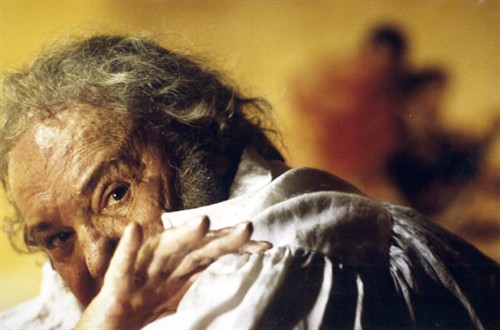The freedoms I have taken in "my"
Goya are a result of my personal vision of this famous Spanish
painter. I did not want to make a historical film, a summary of his
work or a psychological analysis of his character, although all of
this is present in my film. My intention was to extract, from his
broad life, the images I considered to be of key importance. My
film about Goya is based on the premise of telling the story in
reverse order. Allow me to explain: to start off with Goya as he is
exiled in Bordeaux at the age of 82 then end with his birth in a
two- room house of rustic stone in Fuendetodos, a small village in
the desolate Zaragoza countryside. It is therefore a film that runs
backwards, although at a particular moment while avoiding a rigid
chronology, it jumps around in time. The choice of structure is not
whimsical if one bears in mind that my major interest was to
accompany Goya in Bordeaux during the last days of his life, when
his memory had weakened and the shadow of death pursued him: a Goya
who takes refuge in memories from the past as he reflects on his
own life and works.
Goya lived in Bordeaux with his lover Leocadia Zorrilla, who was
40 years younger than he. Leocadia, Goya's faithful partner until
his death, exerted a deep influence over him. Based on the letters
written by Moratín, historians deduce that she had a strong and
domineering character, which undoubtedly helped Goya to put up with
the ravages of old age.
The second leading character and co-protagonist of "my" Goya is
Rosarito, the 13-year-old daughter of Goya and Leocadia, whom the
painter loved and protected. In my film, Rosarito is his friend and
confidant, the person to whom Goya opens his heart and reveals the
secrets of his past life.

Goya fell in love with María Pilar Teresa Cayetana, Duchess of
Alba, who was not only beautiful but charming and intelligent,
according to testimonials from that time. She was also the lover
of, amongst others, Godoy himself, who ruled over Spain at the
time. Goya painted and drew the duchess in many different ways:
with tender love, yearning and even spitefulness. Her image is in
his drawings, engravings and some of his most famous paintings. In
one of them, the Duchess of Alba, dressed as "maja", is pointing
her finger at an inscription on the sand that reads: "Sólo Goya"
(Only Goya). What further proof of love than that? I believe the
memory of that beautiful and fascinating woman accompanied him
until his death.
It is difficult for us to understand 18th Century Spain when Goya
was born. The backwardness of the country was such that diseases
and wars decimated the population, which dropped to seven million,
the figures that existed at the beginning of the century. At that
time, Spain was a sparsely populated country, ignorant and
backward, ruled by an incompetent monarchy and a domineering
Catholic Church. In the countryside, life was miserable - a
situation that lasted well into the 20th Century. The cities and
villages were full of idlers and beggars who dominated the squares
and the steps of the churches.
As one of the "enlightened," Goya sought to change things. It
wasn't easy. In France and England a social and industrial
revolution that would change the world was underway as Spain slept
a long "siesta," waiting for somebody else to save her bacon for
her. The result was a war that devastated the country, plunging it
into misery and helplessness. Goya saw and experienced the
brutality of that war. What he did not see first hand, he was told
about or imagined it: villages laid waste, women, men and children
fleeing from hunger, diseases and death; women raped, tortured men,
corpses ripped apart by cannon shot. Dead bodies piled up in
fields.
Like a premonition, Goya wrote in "Disasters of the War"
(published 50 years after his death): "Sad inklings of what is
going to happen." Perhaps an omen of other wars, a premonition of
the Civil War that yet again devastated Spain in the 1930s?
In autumn of 1792 at the age of 46, Goya contracted a terrible
disease that almost put an end to his life and undoubtedly changed
his character. The illness made him go totally deaf, a condition he
endured for the rest of his life. Goya, cheerful and full of life,
overcame the disease, but its after-effects remained forever in his
work. His deafness gave birth to "Los Caprichos" (The Caprices).
His paintings became less defined and his drawings bolder and more
daring. Although his financial situation depended both on his
salary as a court painter and the money he made from his private
portraits, he took the risk of exposing his personal world. In a
letter addressed to Bernardo de Iriarte he wrote: "I have
managed to make observations in some of my paintings that are not
usually encountered in commissioned works, and in which caprice and
invention have no limits."
CARLOS SAURA.